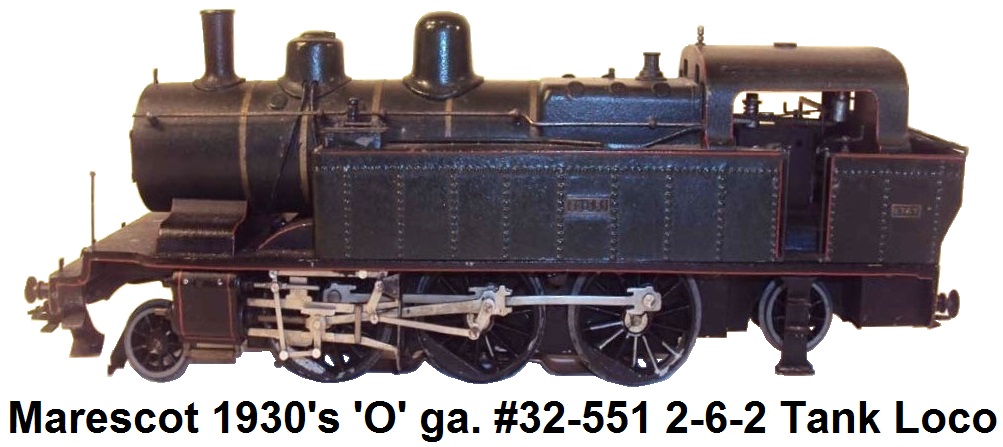 The period from 1920 to 1930 is referred to as the 'Golden Age' as the 1920's saw the emergence of a new
generation of toys that were more functional and detailed. Also, electrification became more wide-spread in the toy train
world, and the catalogs started showing better renditions and used color more widely. Robert Marescot founded his company
around 1920. Marescot was an artisanal French manufacturer known for producing extravagantly French-looking models of
highly detailed 'O' gauge electric trains in the 1920's and 30's. Marescot made very fine scale model trains but it was
a very small company with very limited production and everything they made was considered to be very expensive for the
times. The company was absorbed by Jean-Edmond Fournereau in 1931. Fournereau had been an employee at Marescot in the
1920's but had left in 1928 to create his own models under the name JF.
The period from 1920 to 1930 is referred to as the 'Golden Age' as the 1920's saw the emergence of a new
generation of toys that were more functional and detailed. Also, electrification became more wide-spread in the toy train
world, and the catalogs started showing better renditions and used color more widely. Robert Marescot founded his company
around 1920. Marescot was an artisanal French manufacturer known for producing extravagantly French-looking models of
highly detailed 'O' gauge electric trains in the 1920's and 30's. Marescot made very fine scale model trains but it was
a very small company with very limited production and everything they made was considered to be very expensive for the
times. The company was absorbed by Jean-Edmond Fournereau in 1931. Fournereau had been an employee at Marescot in the
1920's but had left in 1928 to create his own models under the name JF.
 The early models produced by Robert Marescot were somewhat toy-like, but eventually the company took a turn to a more
decidedly modeling orientation. In 1928 Marescot produced a model of an État 4-6-2 Pacific steam outline locomotive and
coaches that was highly realistic. This model is credited with defining the way scale appearance in 3-rail 'O' gauge would
evolve in the 20th century leading right through to modern day production by manufacturers such as MTH,
Lionel, Weaver, and other scale and brass model train makers. The Marescot
trains were built to a scale of 23 meters to one meter. One unique feature introduced at that time was the opening smoke box
door in the locomotive and illumination via an internally installed miniature bulb.
The early models produced by Robert Marescot were somewhat toy-like, but eventually the company took a turn to a more
decidedly modeling orientation. In 1928 Marescot produced a model of an État 4-6-2 Pacific steam outline locomotive and
coaches that was highly realistic. This model is credited with defining the way scale appearance in 3-rail 'O' gauge would
evolve in the 20th century leading right through to modern day production by manufacturers such as MTH,
Lionel, Weaver, and other scale and brass model train makers. The Marescot
trains were built to a scale of 23 meters to one meter. One unique feature introduced at that time was the opening smoke box
door in the locomotive and illumination via an internally installed miniature bulb.
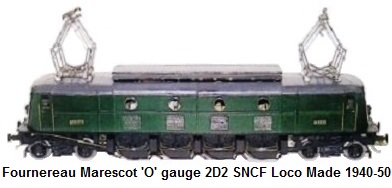 The Marescot État was referred to as a #231. The '231' represents a French classification system, which notes the number of
wheels visible on a locomotive rather than the total. However, the État locomotive was identified by British enthusiasts
using 'Whyte notation' as a 4-6-0 locomotive or more cryptically, as having a Pacific wheel configuration.
The Chemins de fer de l'État was the State Railway of France up until 1938. It was also referred to in France as
the Réseau de l'État or State Network and was an early state-owned French railway company. The prototype Pacific locos
appeared in the lineups of several French railways in the early 1910's and many remained in service through the 1930's.
A total of 1364 of these Pacific type steam locomotives were built for the major French railway companies.
The Marescot État was referred to as a #231. The '231' represents a French classification system, which notes the number of
wheels visible on a locomotive rather than the total. However, the État locomotive was identified by British enthusiasts
using 'Whyte notation' as a 4-6-0 locomotive or more cryptically, as having a Pacific wheel configuration.
The Chemins de fer de l'État was the State Railway of France up until 1938. It was also referred to in France as
the Réseau de l'État or State Network and was an early state-owned French railway company. The prototype Pacific locos
appeared in the lineups of several French railways in the early 1910's and many remained in service through the 1930's.
A total of 1364 of these Pacific type steam locomotives were built for the major French railway companies.
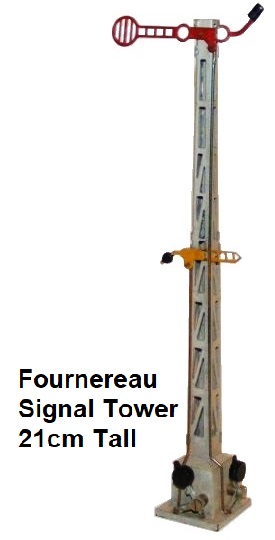 The Marescot model was fitted with 3 axles coupled, front bogie and rear axle. The tender had 2 bogies. The loco was equipped
with a working headlight and was powered by a Maxon (Swiss made) 24 volt motor that could be used with AC or DC power. The
transmission of movement was accomplished via a series of gears, pinions and conical couplings to ensure perfect grip and
traction. The locomotive length was 52 cm, height 10 cm, and width 7.5 cm. It weighed 2 kilograms. At the time of its
release, this engine was the most modernly engineered model for 'O' gauge. It faithfully reproduced the famous French
prototype in all of its details, including the Waelschaerts slide movement. Although it was a scale model, company flyers and
advertisements claimed that it was, "very attractive both for the child and for the amateur". Other features included
automatic direction reversal activated via the handle of the transformer rheostat or by hand on the machine, at the will of
the operator via a switch lever located in the engine cab that could stop the machine even when the current to the track was
turned on. The locomotive wheels were
made of special cast iron that literature claimed were, "unbreakable and very resistant to wear on the bearing". A new system
of a socket outlet with rollers was implemented. The body of the loco was finely engraved in thick metal, with nickel-plated
fittings. The paint was dark green with yellow and gold threads, with the front and the edges trimmed in black. The Tender
featured tool boxes with doors that opened. It came in a wooden cloisonné and cardboard box. At that time it sold for
830₣ (French Francs).
The Marescot model was fitted with 3 axles coupled, front bogie and rear axle. The tender had 2 bogies. The loco was equipped
with a working headlight and was powered by a Maxon (Swiss made) 24 volt motor that could be used with AC or DC power. The
transmission of movement was accomplished via a series of gears, pinions and conical couplings to ensure perfect grip and
traction. The locomotive length was 52 cm, height 10 cm, and width 7.5 cm. It weighed 2 kilograms. At the time of its
release, this engine was the most modernly engineered model for 'O' gauge. It faithfully reproduced the famous French
prototype in all of its details, including the Waelschaerts slide movement. Although it was a scale model, company flyers and
advertisements claimed that it was, "very attractive both for the child and for the amateur". Other features included
automatic direction reversal activated via the handle of the transformer rheostat or by hand on the machine, at the will of
the operator via a switch lever located in the engine cab that could stop the machine even when the current to the track was
turned on. The locomotive wheels were
made of special cast iron that literature claimed were, "unbreakable and very resistant to wear on the bearing". A new system
of a socket outlet with rollers was implemented. The body of the loco was finely engraved in thick metal, with nickel-plated
fittings. The paint was dark green with yellow and gold threads, with the front and the edges trimmed in black. The Tender
featured tool boxes with doors that opened. It came in a wooden cloisonné and cardboard box. At that time it sold for
830₣ (French Francs).



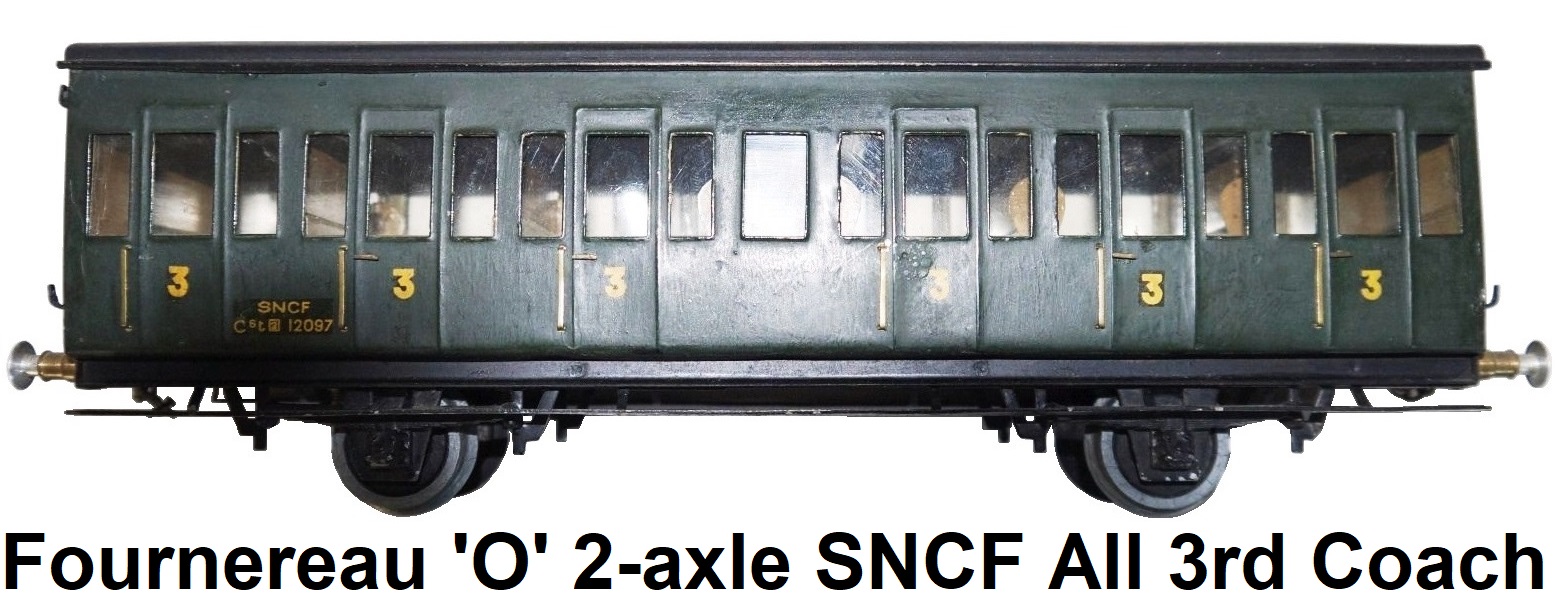 Today these original État locomotives are very rare and when located they command large sums to purchase. The early
Marescot models are easily identifiable via the French Flag marking with the letters 'R M Paris' appearing on the underside.
A rarer version has the 'LOCO' marking, which was the commercial trademark utilized by Marescot. A 1936 era Marescot
electric 2-3-1 (4-6-2) État Locomotive #231-612 and a 4-axle 2-bogie tender #22120 painted in fine-lined dark green, sold
for $2959 at a Christie's Auction held in 1999.
Today these original État locomotives are very rare and when located they command large sums to purchase. The early
Marescot models are easily identifiable via the French Flag marking with the letters 'R M Paris' appearing on the underside.
A rarer version has the 'LOCO' marking, which was the commercial trademark utilized by Marescot. A 1936 era Marescot
electric 2-3-1 (4-6-2) État Locomotive #231-612 and a 4-axle 2-bogie tender #22120 painted in fine-lined dark green, sold
for $2959 at a Christie's Auction held in 1999.
Marescot Fournereau 'O' gauge Passenger Wagons




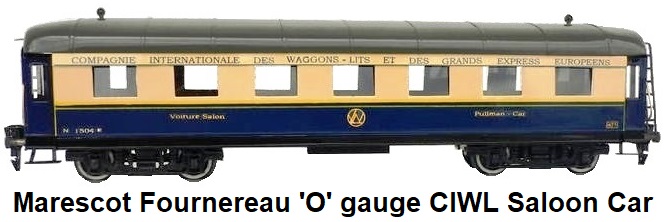


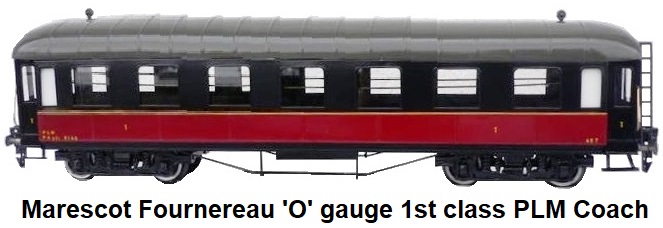
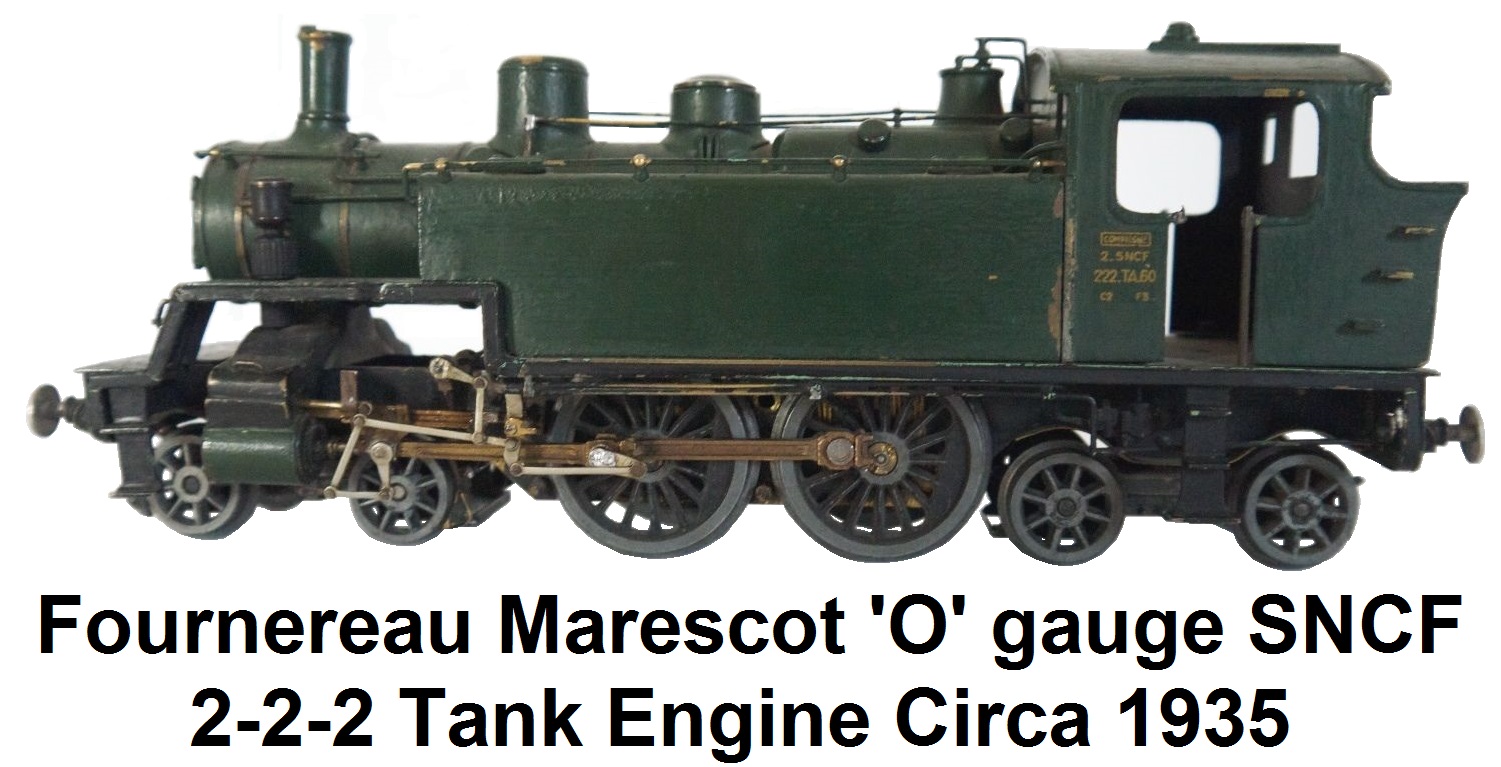 Marescot was taken over in 1931 by Jean-Edmond Fournereau leading to a number of pieces being referred to as
'Fournereau-Marescot', or 'Marescot-Fournereau'. Electric outline locomotives cast in bronze ranging from 2-C-1's
to 1-D-1's were also made, as well as 2-2-0 and 2-4-1 tender steam locomotives, an 0-3-0 Tank loco, a 2-2-2 Tank loco
and a 1-3-1 Tank loco. The 2-3-1 Pacific type remained in the lineup unchanged for the most part. Some detail parts
were added, and the loco was offered for the first time in kit form. 40 cm passenger carriages and freight wagons were also
produced. These products were also offered as unpainted kits. Marescot coach classes are easily identified by the number of
windows. 3rd class has 9 windows, 2nd
class has 8 and 1st class has 7. Early coaches had balsa wood roofs, but later coaches have tinplate roofs. Since these
coaches were offered in kit form they are frequently found decorated with custom paint schemes or in recognizable liveries
of popular pre-war era French and European rail lines like État, CIWL, SNCF, EST, SUD, Ouest (former État lines) and NORD.
Marescot was taken over in 1931 by Jean-Edmond Fournereau leading to a number of pieces being referred to as
'Fournereau-Marescot', or 'Marescot-Fournereau'. Electric outline locomotives cast in bronze ranging from 2-C-1's
to 1-D-1's were also made, as well as 2-2-0 and 2-4-1 tender steam locomotives, an 0-3-0 Tank loco, a 2-2-2 Tank loco
and a 1-3-1 Tank loco. The 2-3-1 Pacific type remained in the lineup unchanged for the most part. Some detail parts
were added, and the loco was offered for the first time in kit form. 40 cm passenger carriages and freight wagons were also
produced. These products were also offered as unpainted kits. Marescot coach classes are easily identified by the number of
windows. 3rd class has 9 windows, 2nd
class has 8 and 1st class has 7. Early coaches had balsa wood roofs, but later coaches have tinplate roofs. Since these
coaches were offered in kit form they are frequently found decorated with custom paint schemes or in recognizable liveries
of popular pre-war era French and European rail lines like État, CIWL, SNCF, EST, SUD, Ouest (former État lines) and NORD.
Marescot Fournereau 'O' gauge Kit-built Freight Wagons
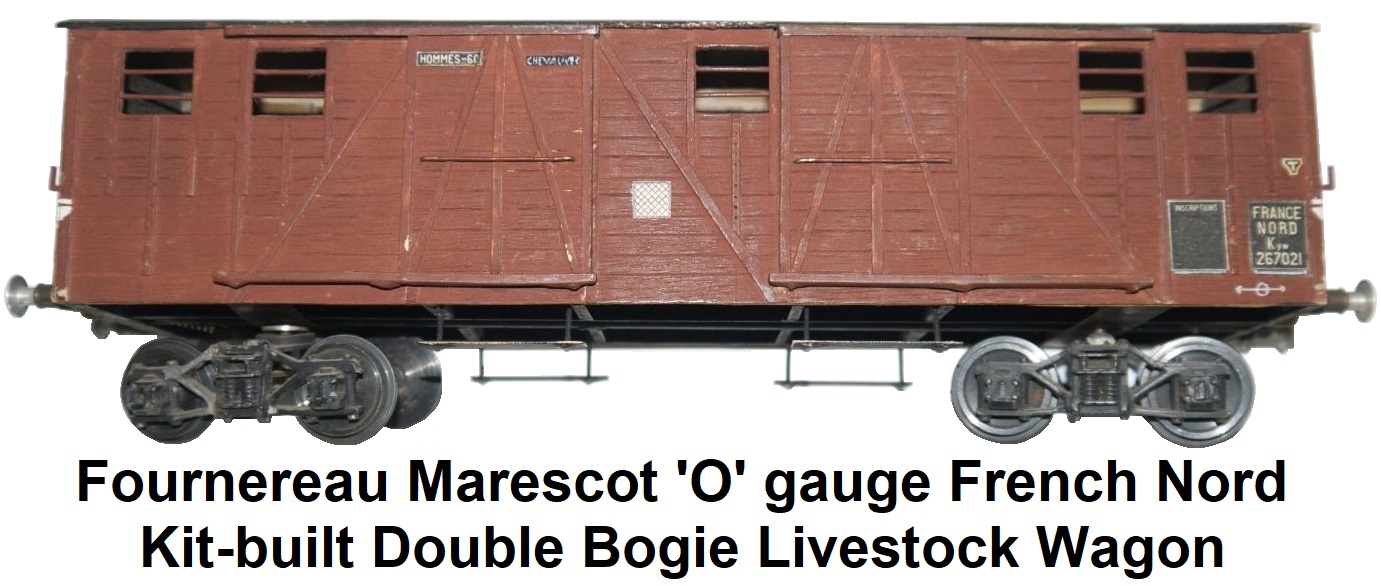
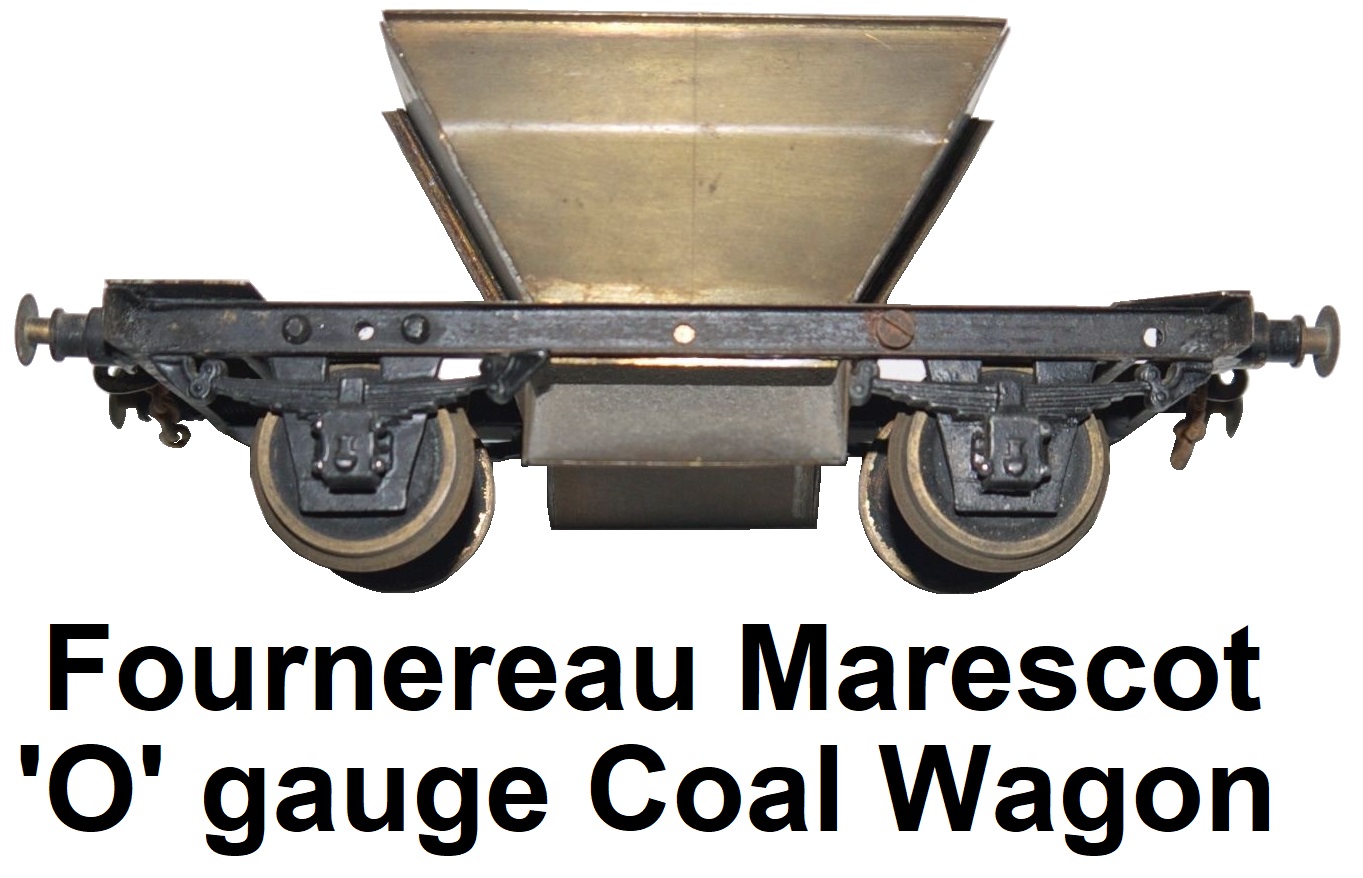
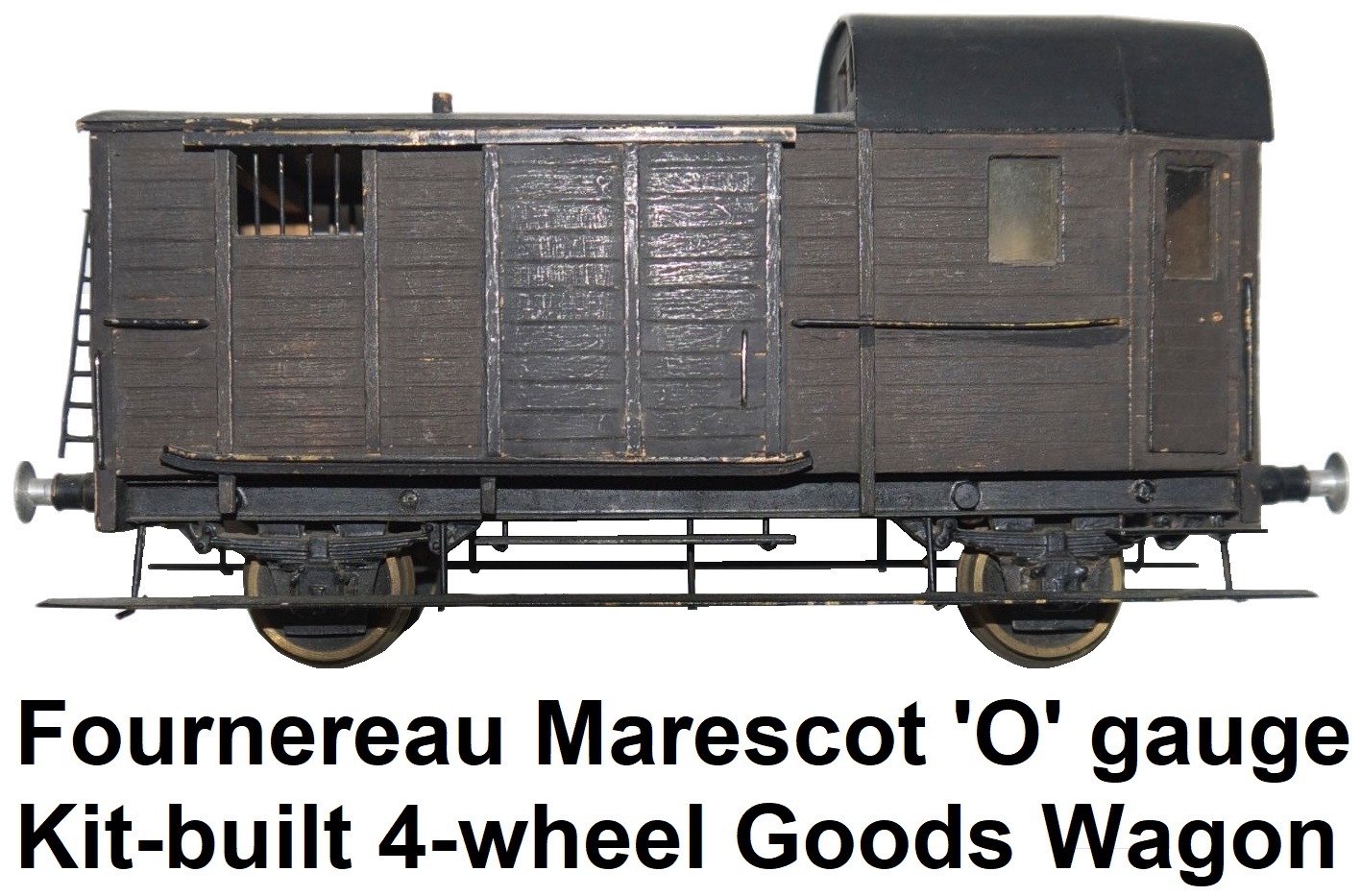
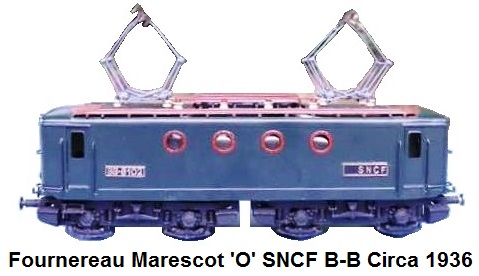 Fournereau Marescot issued sets that included a loco, tender, 2, 3 or 4 passenger cars, a transformer
and 3-rail sectional track. The track was tubular steel with wooden ties. They also made several freight wagons in
kit form. The company continued to manufacture trains through 1960, with Jean-Edmond's son taking over in the 1950's.
The last known catalogue was published in 1955.
Fournereau Marescot issued sets that included a loco, tender, 2, 3 or 4 passenger cars, a transformer
and 3-rail sectional track. The track was tubular steel with wooden ties. They also made several freight wagons in
kit form. The company continued to manufacture trains through 1960, with Jean-Edmond's son taking over in the 1950's.
The last known catalogue was published in 1955.
As well as being a model railway manufacturer, Jean-Edmond also founded Loco Revue magazine in March
1937, and published a book on French steam locomotives titled "Locomotives A Vapeur De La S.N.C.F.", sometime around 1947.
The manufacturing facilities were first established in the Paris region in former stables facing Saint-Goustan. Later
they moved to Auray. At its peak, the Fournereau workshop employed about fifteen people and produced up to 3,000 copies
of its most popular models. The model-making magazines were initially written and published in the family home. Loco Revue
magazine celebrated their 75th Anniversary in 2012 and is still in monthly publication today with circulation
of 30,000 readers. It belongs to the group LR Presse which deals with themes around railway modeling. It is the oldest model
railway journal of France. Christian Fornereau, the grandson of Jean-Edmond, is the current editor in chief.
As a tribute to Marescot, the firm Fulgurex issued a commemorative set of
train accessories contained in a presentation box. This set of typical French train signposts and semaphores was made by
Alpha Models, and is a limited edition.

